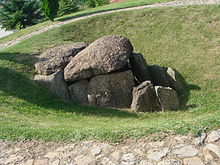Mámoa
Mámoa or Mamoa are popularly and in the technical language of archaeologists, the roughly 5000 hills above the megalithic complexes in Spanish Galicia and northern Portugal . In addition, terms such as Medoña, Medorra, Mota or Meda are in use. The name comes from the Romans who named the monuments Mammulas because of their resemblance to the womb of a woman. The diameter of a Mámoa is between 10 and 30 m. The shape and size of the once hemispherical mámoas, some of which were complicated structures made of earth with built-in stones, have lost due to erosion and illegal excavations. All of the mamaas have been robbed and almost all of them are in very bad shape.
The megalithic complexes covered by Mámoas are called Anta , Antela, Arca, Arqueta, Arquiaña, Pedra de Arca, Forno or Capela , similar to Portugal , with which Galicia seems to form a prehistoric unit up to the Duero . The megalithic systems:
- are initially gangless polygonal (Antas 6 + 7 from Mourela, Chao de Arqueta)
- from the Middle Neolithic onwards have short corridors, often facing east (Anta da Pisosa, Cova da Moura in Argalo, Capela dos Mouros , Mámoa by Chan da Arquiña , Casa dos Mouros and the dolmen of Dombate ).
- received in the late Neolithic again aisle-free, box-like forms (Anta da mámoa 39 de Ortigueira, Anta da mámoa 229 de Vilavella, Casota de Berdoias, Sáa de Parga).
The acidic soils and the enormous density of settlements have ensured that no settlements have yet been discovered. The dilemma also lies in the inadequate dating. It is not even verifiable that there was a Neolithic premegalithic in Galicia , which is otherwise found everywhere. The problems are that before the megalithic phase:
- Grain cultivation and deforestation can be demonstrated, but domestic pets cannot be documented.
- the round axes used are not related to the find and the shape is to be regarded as Neolithic , but this context is uncertain.
- Atypical pottery shards and stone tools were found in the upper layers of the Reiro find, which indicate epipalaeolithic acculturation.
- Premegalithic pottery was found under abrises on the Moraza (also Morazza) peninsula, which is also found on the shell mound of Molto do Sabastião and on Neolithic sites in the Estremadura .
- So far, apart from the huts made of organic materials on the Moraza peninsula (O Regueiriño, Fontenla), which cannot be classified in terms of time, there is no evidence of settlement.
See also
literature
- AA Rodríguez Casal: The Megalithic Culture in Galicia. In: Problems of megalithic grave research. Lectures on the 100th birthday of Vera Leisner (= Madrid Research Vol. 16). de Gruyter, Berlin 1989, ISBN 3-11-011966-8 , pp. 53-72.




